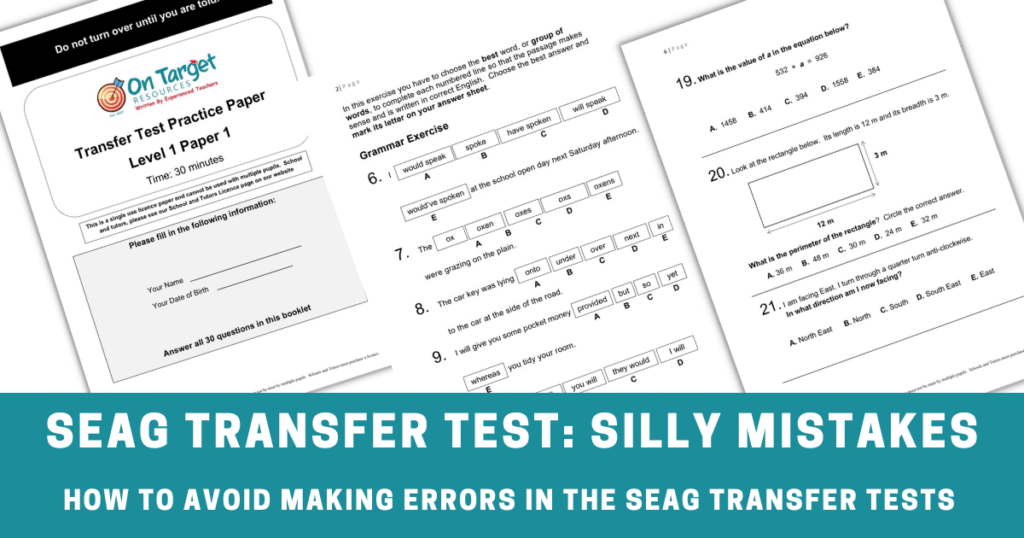Top Common Silly Mistakes in SEAG Transfer Test
When it comes to the SEAG Transfer Test, it’s often not the hardest questions that trip pupils up—but the small, avoidable, silly mistakes in the SEAG Transfer Test. Time and again, tutors, teachers and parents report that bright pupils lose marks not because they didn’t know the answer, but because they rushed, misread, or ignored instructions.
This blog explores the most frequent silly mistakes made in the SEAG Transfer Test, and more importantly—how your child can avoid them.

Why “Silly Mistakes in SEAG Transfer Test” Matter
The SEAG test is tightly timed and packed with short-answer and multiple-choice questions in English and Maths, based on the Northern Ireland Key Stage 2 curriculum. Even a few minor errors—like missing a punctuation mistake or skipping a line in a word problem—can make a big difference in the final score.
These are highly preventable, but only if pupils know what to watch out for.
🔍 Common Silly Mistakes in the SEAG Transfer Test
🧠 English Mistakes
| Mistake | Why It Happens | Avoid It By… |
|---|---|---|
| Misreading the Question | Skimming or rushing | Underline key parts of the question |
| Missing key details in the text | Not reading the full paragraph | Always read around the answer |
| Confusing homophones (e.g. their/there/they’re) | Lack of proofreading | Practise spotting errors in context |
| Missing punctuation and spelling mistakes | Rushing or not proofreading | Build a checklist habit (see below) |
| Not using evidence from the text | Forgetting to refer back | Use a P.E. method: Point → Evidence |
➗ Maths Mistakes
| Mistake | Why It Happens | Avoid It By… |
|---|---|---|
| Copying numbers incorrectly | Careless transcribing | Check numbers after writing them |
| Skipping steps in working out | Overconfidence or time pressure | Write every step—even if it seems obvious |
| Wrong operation (adding instead of subtracting) | Not reading word problems carefully | Highlight or circle key words |
| Not reading what unit of measure an answer shoul dbe in (cm, £) | Focusing only on numbers | Add “Check units” to your checklist |
| Leaving a question blank or missing a question on the answer sheet | Not sure how to start, day dreaming and not concentrating | Encourage writing something—even partial work can earn marks. Double-check where the mark should go and if it is the right question |
✅ SEAG Accuracy Checklist for Pupils
Before moving on to the next question, your child should ask:
- Did I answer exactly what the question asked?
- Have I read the full sentence or paragraph?
- Have I checked the unit of measure (Maths)?
- Did I check for spelling errors or number copying errors?
- Have I written the answer in the correct space?
- Did I rush through the proofreading sections (English)?
Print this out or write it on a sticky note beside their practice paper—soon, it’ll become a habit.
⏱️ Accuracy Under Pressure: Timed Practice Tips
It’s easy to be accurate when there’s no clock ticking. But in SEAG, time pressure is real. Here’s how to build accuracy and speed together:
✍️ Exercises That Work:
- One-minute proofreads: Give a short passage and ask your child to find 5 errors in 60 seconds.
- Flash maths: Show a worked-out problem and ask “What’s the mistake?” to train error-spotting.
- Comprehension checkups: After reading a passage, ask 3 rapid-fire questions that require exact wording or detail.
- Timed mock sections: Use practice papers in chunks (e.g. 15 minutes of just short-answer questions).
🧠 Bonus: Top Silly Mistake Tip
When reviewing your child’s completed practice paper, consider recording both their actual score and a “potential score” that reflects the marks they could have achieved without avoidable errors. Highlighting the impact of small mistakes in this way can be a powerful motivator, helping pupils recognise the value of accuracy and attention to detail in future assessments.
Final Thought: Accuracy Is Just as Important as Knowledge
Getting ready for the SEAG Transfer Test isn’t just about learning content—it’s about avoiding the mistakes that cost easy marks.
At On Target Resources, our SEAG-style practice papers are designed to:
- Reflect real test timing and layout
- Highlight where silly mistakes commonly happen
- Give pupils a chance to correct and learn before test day
